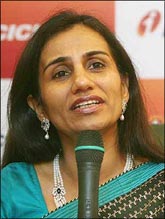 Indian women may not have proportionate representation in companies, but they are better off than women elsewhere.
Indian women may not have proportionate representation in companies, but they are better off than women elsewhere.
Eleven per cent of 240 large companies -- Indian-owned as well as multinational, private as well as state-owned -- have women CEOs, according to a study carried out by executive search firm EMA Partners. In comparison, only 3 per cent of the Fortune 500 companies have women CEOs.
As many as 54 per cent of the women CEOs are, according to EMA Partners, in financial services. "Amongst private and foreign banks, women almost outnumber men. This has been helped in no mean measure by women from ICICI Bank who have joined other financial institutions in recent times," said EMA Partners managing partner K Sudarshan.
Thus, Chanda Kochhar is the managing director and CEO of ICICI Bank, ex-ICICI Prudential chief Shikha Sharma heads Axis Bank and Kalpana Morparia is the country head of JPMorgan.
Renuka Ramnath, the former CEO of ICICI Ventures, will run a yet unnamed fund. In addition, Naina Lal Kidwai occupies the corner office at HSBC and Meera Sanyal at ABN Amro.
Manisha Girotra heads UBS, Ashu Suyash Fidelity. In the Fortune 500 list, only 7 per cent women CEOs are from financial services.
Eleven per cent of the Indian women CEOs are in the media and another 11 per cent in pharmaceuticals. Thus, Kiran Mazumdar-Shaw is the chairman and managing director of Biocon and Villoo Morawala Patel is the founder, chairman and managing director of Avesthagen.
Eight per cent are in consulting and another 8 per cent in FMCG and consumer durables. The big names here are Vinita Bali of Britannia and Nadia Chauhan of Parle Agro.
Four per cent each can be found in manufacturing and IT & IT-enabled services. The largest personal computer company in the country, Hewlett-Packard, is headed by Neelam Dhawan.
In the Fortune 500 list, in contrast, 48 per cent of the women CEOs came from FMCG and consumer durables. Manufacturing and IT & IT-enables services returned 13 per cent each.
Sudarshan said the IT and IT-enabled services do not have many women CEOs because it requires a fair amount of travel to on-site locations. It also comes with the pressure of working through multiple time zones.
Manufacturing has traditionally not attracted too many women because of the nature of the business and the location of factories in the interiors.
Thirty-five per cent of the women CEOs, according to EMA Partners, are also promoters of their companies.
This includes Rajshree Pathy who runs Rajshree Sugars & Chemicals and Meher Pudumjee who is the chairperson of Thermax. The other 65 per cent are professional CEOs.
Still, most experts say women are under-represented in corner offices across the world.
"Given that roughly about 50 per cent of our population is female, that about 50 per cent of staff is female in most markets, the gender is hugely unrepresented in boards and at the CEO level," said EMA Partners International Chairman James Douglas.
"For instance, out of 1,000 public companies in the USA, with at least $1 billion in annual revenue, there are only 30 female CEOs. In the UK's FTSE 100 list, there are just three."
According to various studies and EMA Partners' estimates, there is no shortage of female talent. In Germany, over 25 per cent executives are women, in the UK more than 30 per cent and in France over 35 per cent.
In board appointments, the numbers decline further. In Germany, just over 10 per cent of board members are women, according to EMA Partners. In France, it is as low as 7 per cent.
To address this imbalance, some countries have insisted on minimum levels of board female members. Norway, in 2004, inaugurated a quota system stipulating that 40 per cent of the board of a publicly quoted company should be women otherwise that company could be delisted. In 2007, Spain decided to go the same way.
Image: Chanda Kochhar, managing director and CEO, ICICI Bank







 © 2025
© 2025